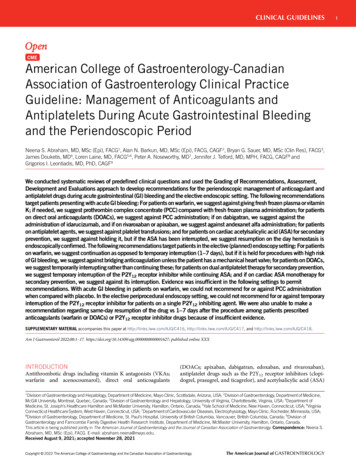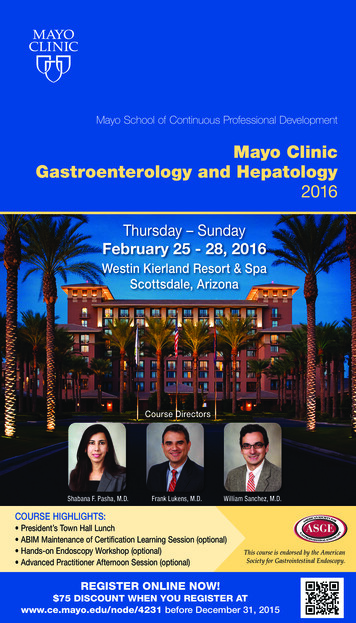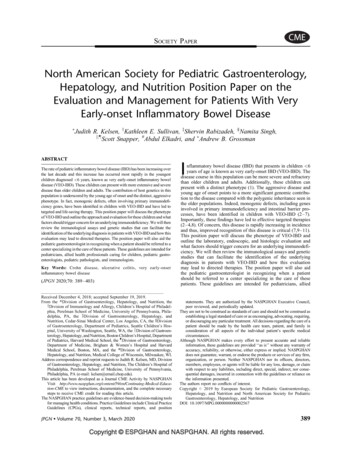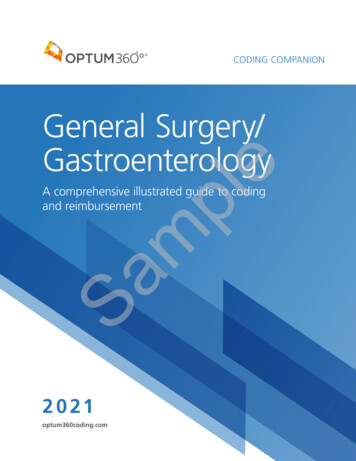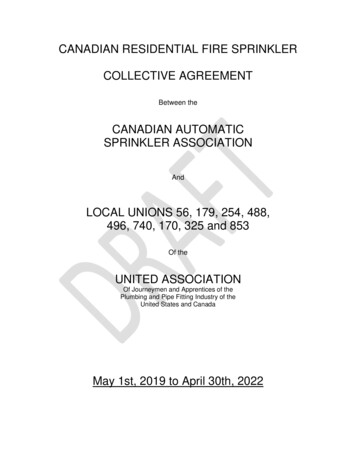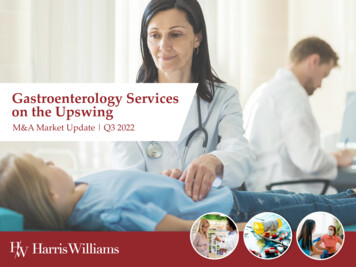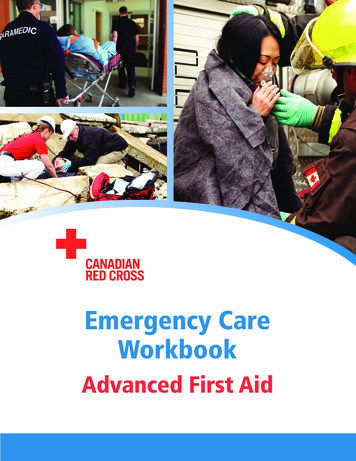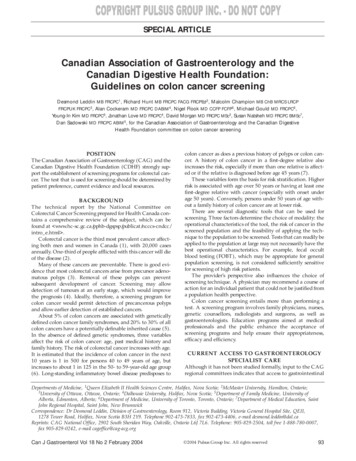
Transcription
SPECIAL ARTICLECanadian Association of Gastroenterology and theCanadian Digestive Health Foundation:Guidelines on colon cancer screeningDesmond Leddin MB FRCPC1, Richard Hunt MB FRCPC FACG FRCPEd2, Malcolm Champion MB ChB MRCS LRCPFRCPUK FRCPC3, Alan Cockeram MD FRCPC DABIM4, Nigel Flook MD CCFP FCFP5, Michael Gould MD FRCPC6,Young-In Kim MD FRCPC6, Jonathan Love MD FRCPC4, David Morgan MD FRCPC MSc2, Susan Natsheh MD FRCPC BMSc7,Dan Sadowski MD FRCPC ABIM5, for the Canadian Association of Gastroenterology and the Canadian DigestiveHealth Foundation committee on colon cancer screeningPOSITIONThe Canadian Association of Gastroenterology (CAG) and theCanadian Digestive Health Foundation (CDHF) strongly support the establishment of screening programs for colorectal cancer. The test that is used for screening should be determined bypatient preference, current evidence and local resources.BACKGROUNDThe technical report by the National Committee onColorectal Cancer Screening prepared for Health Canada contains a comprehensive review of the subject, which can befound at ntro e.html .Colorectal cancer is the third most prevalent cancer affecting both men and women in Canada (1), with 20,000 casesannually. One-third of people afflicted with this cancer will dieof the disease (2).Many of these cancers are preventable. There is good evidence that most colorectal cancers arise from precursor adenomatous polyps (3). Removal of these polyps can preventsubsequent development of cancer. Screening may allowdetection of tumours at an early stage, which would improvethe prognosis (4). Ideally, therefore, a screening program forcolon cancer would permit detection of precancerous polypsand allow earlier detection of established cancers.About 5% of colon cancers are associated with geneticallydefined colon cancer family syndromes, and 20% to 30% of allcolon cancers have a potentially definable inherited cause (5).In the absence of defined genetic syndromes, three variablesaffect the risk of colon cancer: age, past medical history andfamily history. The risk of colorectal cancer increases with age.It is estimated that the incidence of colon cancer in the next10 years is 1 in 500 for persons 40 to 49 years of age, butincreases to about 1 in 125 in the 50- to 59-year-old age group(6). Long-standing inflammatory bowel disease predisposes tocolon cancer as does a previous history of polyps or colon cancer. A history of colon cancer in a first-degree relative alsoincreases the risk, especially if more than one relative is affected or if the relative is diagnosed before age 45 years (7).These variables form the basis for risk stratification. Higherrisk is associated with age over 50 years or having at least onefirst-degree relative with cancer (especially with onset underage 50 years). Conversely, persons under 50 years of age without a family history of colon cancer are at lower risk.There are several diagnostic tools that can be used forscreening. Three factors determine the choice of modality: theoperational characteristics of the tool, the risk of cancer in thescreened population and the feasibility of applying the technique to the population to be screened. Tests that can readily beapplied to the population at large may not necessarily have thebest operational characteristics. For example, fecal occultblood testing (FOBT), which may be appropriate for generalpopulation screening, is not considered sufficiently sensitivefor screening of high risk patients.The provider’s perspective also influences the choice ofscreening technique. A physician may recommend a course ofaction for an individual patient that could not be justified froma population health perspective.Colon cancer screening entails more than performing atest. A screening program involves family physicians, nurses,genetic counsellors, radiologists and surgeons, as well asgastroenterologists. Education programs aimed at medicalprofessionals and the public enhance the acceptance ofscreening programs and help ensure their appropriateness,efficacy and efficiency.CURRENT ACCESS TO GASTROENTEROLOGYSPECIALIST CAREAlthough it has not been studied formally, input to the CAGregional committees indicates that access to gastrointestinalDepartments of Medicine, 1Queen Elizabeth II Health Sciences Centre, Halifax, Nova Scotia; 2McMaster University, Hamilton, Ontario;3Unversity of Ottawa, Ottawa, Ontario; 4Dalhousie University, Halifax, Nova Scotia; 5Department of Family Medicine, University ofAlberta, Edmonton, Alberta; 6Department of Medicine, University of Toronto, Toronto, Ontario; 7Department of Medical Education, SaintJohn Regional Hospital, Saint John, New BrunswickCorrespondence: Dr Desmond Leddin, Division of Gastroenterology, Room 912, Victoria Building, Victoria General Hospital Site, QEII,1278 Tower Road, Halifax, Nova Scotia B3H 2Y9. Telephone 902-473-7833, fax 902-473-4406, e-mail desmond.leddin@dal.caReprints: CAG National Office, 2902 South Sheridan Way, Oakville, Ontario L6J 7L6. Telephone: 905-829-2504, toll free 1-888-780-0007,fax 905-829-0242, e-mail cagoffice@cag-acg.orgCan J Gastroenterol Vol 18 No 2 February 2004 2004 Pulsus Group Inc. All rights reserved93
Leddin et al(GI) specialty care varies across the country. Timely emergency care is generally available but wait times for electiveGI consultation are three to 10 months. It is clear that, inmany parts of Canada, access to specialist GI care is limited.This problem needs to be addressed, and additional humanand physical resources acquired, before new cancer screeningprograms are initiated. In other regions, it appears that theresources are in place but are underutilized due to financialand other constraints.CANADIAN, BRITISH AND AMERICANGUIDELINESWe are indebted to our American and British colleagues fortheir work in preparing practice guidelines (8,9). The CAGCDHF group has reached the same conclusions based on ourreview of the evidence. The guidelines outlined here are verysimilar to those of the American Gastroenterology Association(AGA) and the British Society of Gastroenterology (BSG) onscreening of high risk groups. We differ only in that we recommend fecal occult blood testing every two years instead ofevery year, and we suggest that clinical judgement determinethe type of follow-up for advanced adenomas (instead ofcolonoscopy after three years, as in the AGA guidelines).STRATIFICATION OF RISK OF COLON CANCERThe majority of the population does not have an affected relative and is at average risk of developing colorectal cancer.Taking the population as a whole, it has been estimated that a50-year-old person has a 6% lifetime risk of developing thistumour.Certain groups are at higher than average risk. The largestsuch group comprises patients who have a first-degree relativewith colon cancer. The risk is especially high if colon cancer orother related cancers occur in young persons in more than onegeneration. The family history in these cases may be indicativeof an underlying genetic defect. Patients with a history of familial adenomatous polyposis (FAP) or hereditary nonpolyposiscolon cancer are also at significantly increased risk (10), as arethose with long-standing inflammatory bowel disease (11).At present there is no Canadian approach to screening ofhigh risk patients. FOBT does not have adequate sensitivity. Ascreening program for colon cancer must consider theresources needed for endoscopic screening of high riskpatients.Patients testing positive for occult blood should undergocolonoscopy because colon cancer will be found in about 12%(12).SCREENING OPTIONSDetailed information on the operating characteristics ofscreening tests is available at ndcc/intro e.html . That review isextensively referenced. The intent of the present article is tosummarize the advantages and disadvantages of each testingmodality.FOBTThe major advantage of FOBT is the relative ease of initialtesting. The test can be administered by the patient or at theprimary care level, and does not require technical expertise orspecialist referral.94Disadvantages include poor sensitivity and specificity.Logistical difficulties arise for primary care practitioners who areresponsible for scheduling the test. In addition, the test isdesigned to detect cancers at an early stage and not specifically tointerrupt the polyp-cancer sequence. Therefore, it is more anearly detection strategy rather than a truly preventivetechnique.Feasibility: No Canadian clinical trial data are available, butthe feasibility of FOBT has been studied in detail byHealth Canada using computer modelling ndcc/index.html .Based on Health Canada projections we can estimate that 1 to1.5 full-time gastroenterologists (or equivalent) would berequired to screen 100,000 persons.ColonoscopyThe advantages of this test are its high sensitivity and specificity for the detection of both polyps and carcinomas, providedthat there is a complete examination of a well-prepared colon.Controlled studies of efficacy are lacking but most gastroenterologists would agree that colonoscopy is the gold standardtest.The major disadvantage of this test is that it requires considerable physical resources and skilled personnel. Expertise isrequired to successfully and safely pass the colonoscope to thececum and to undertake polypectomy. Complications canresult from sedation and the risk of perforation or bleeding isapproximately 1:1000 to 1:2000 cases (with rare fatalities).Patient adherence may be limited by the fact that the test canbe uncomfortable, even with sedation. Some lesions aremissed. Moreover, in approximately 5% of cases, it is not possible to visualize the entire colon, either because of poor preparation or a technically difficult bowel.Feasibility: There have been no studies estimating the numberof colonoscopies that would be required to screen the averagerisk population in Canada if this were the primary screeningtool. Nor is it known what percentage of the at-risk populationalready undergo colonoscopy each year. Waiting lists for nonscreening diagnostic colonoscopy vary considerably throughout Canada, and it is unlikely that a colonoscopic screeningprogram could be put in place, in any part of the country, without significant further investment in human and physicalresources.It is generally accepted that colonoscopy is the appropriatescreening tool for high risk individuals, but there is currentlyno organized program to provide screening for these individuals.The magnitude of the problem and required resources are notknown.Flexible sigmoidoscopyThe advantage of flexible sigmoidoscopy is that it is sensitiveand specific for distal colonic lesions. The test can be performed by nurses or by nonspecialist physicians.The disadvantage is that some patients have proximaltumours only, which would escape detection. The risk of perforation is minimal.Feasibility: As with colonoscopy, the human and physicalresources are not in place to institute a national flexible sigmoidoscopy-based program. The amount of resources requiredis not known.Debate continues as to whether it is necessary to performcolonoscopy on every patient in whom a distal colonicCan J Gastroenterol Vol 18 No 2 February 2004
CAG-CDHF guidelines on colon cancer screeningMen and WomenSymptomaticDiagnostic Work-upAsymptomaticAge 50 yearsAge 50 yearsNegative FamilyHistoryNo screeningNegative FamilyHistoryAverage Risk screening:Screening tool to bedetermined byphysician, patientpreference, evidence andavailable resources.Figure 1) Approach to average risk screeningadenoma has been detected. The CAG-CDHF position is thatcolonoscopy should be offered to all such patients, but furtherstudies are awaited.Flexible sigmoidoscopy combined with FOBTThere are limited data on the use of combination screening. Itis likely to enhance the detection rate compared with FOBTalone, but at the cost of increased workload demands. NoCanadian feasibility data are available.Double contrast barium enemaThe major advantage of this test is that it can be performed byradiology technicians. Furthermore, barium x-rays permit evaluation of the entire colon.Disadvantages include the fact that it is less sensitiveand specific than colonoscopy, because of the presence ofretained stool. Abnormalities need to be followed up withcolonoscopy. The test involves radiation exposure, butthere is no evidence that this is a significant problem.Feasibility: This test is feasible in that an extensive radiological infrastructure already exists in most health careinstitutions. Therefore, a radiology-based populationscreening program could take place without significantadditional human and infrastructure investment. On theother hand, many radiology facilities are already working atmaximum capacity. The amount of resources required is notknown.Can J Gastroenterol Vol 18 No 2 February 2004RECOMMENDATIONSScreening of individuals at average riskColon cancer is uncommon before the age of 50 years. Theprobability of developing colon cancer in the next 10 years is1:1000 in the 30 to 39 age group, 1:125 in the 50 to 59 agegroup and 1:50 at age 60 to 69 years(7). Most authorities recommend that screening be offered to persons aged 50 to 65years. This age group constitutes approximately 20% of theCanadian population.The CAG and CDHF endorse the algorithm shown inFigure 1, which is similar, but not identical, to that in theAGA guidelines (8).Symptomatic individuals cannot be considered as screeningcandidates. They need appropriate diagnostic work up.Asymptomatic individuals below the age of 50 years are unlikely to have colon cancer and screening this group is not considered helpful. The strategies outlined below each haveadvantages and disadvantages. We do not contend that they areequally effective nor should this idea be suggested to patients.Individuals over the age of 50 years with a negative familyhistory should undergo screening with one of the followingstrategies:1. FOBT every two years. The AGA guidelinesrecommend screening yearly using a guaiac-based testwith dietary restrictions or an immunochemical test forheme without restrictions;95
Leddin et alNote: The Canadian Expert Panel commissioned byHealth Canada recommended occult blood testingevery two years. Although yearly occult blood testingdoes increase the detection of cancer as compared withevery two years, it was not felt that this justified theresulting considerable increase in workload. In addition,testing every two years would be more achievable froma primary care perspective. The CAG-CDHF supportsthe position taken by the Health Canada committeeand recommends that, if FOBT is used, it be performedevery two years.2. Flexible sigmoidoscopy every five years. The interval offive years between examinations is shorter than thatrecommended if colonoscopy is used, because flexiblesigmoidoscopy may be less sensitive than colonoscopyeven in the area examined, or;3. Flexible sigmoidoscopy combined with FOBT everyfive years. The rationale for the interval is mentionedabove, or;4. Double contrast barium enema every five years. Thelesser sensitivity and specificity of this test comparedwith colonoscopy is the rationale for the shorterscreening interval compared with colonoscopy, or;5. Colonoscopy every 10 years. The high sensitivity andspecificity of this test means that the interval betweentests can be twice as long as that of the other testsmentioned above.Screening of individuals at higher riskSome groups are at increased risk of colon cancer. Theseinclude patients who have first-degree relatives with the disease, a family history that suggests a definable genetic abnormality, FAP or long-standing colonic inflammatory boweldisease. Genetic counselling is an important part of the management of patients with these conditions. There should beprovincial strategies to ensure timely access to all appropriateservices including genetic counselling and testing.The CAG and CDHF guidelines are similar to those of theAGA (8). These are reproduced in modified form (Figure 2).HIGH RISK GROUPS: DEFINITIONS, CRITERIAFOR DIAGNOSIS, AND RATIONALE FORSCREENING RECOMMENDATIONSThe timing of initial colonoscopy and repeat examinations isbased on our current understanding of the natural history ofcolonic polyps and cancer in the populations at risk. For example, screening for patients with HNPCC begins at an earlierage than that for persons who have no first-degree relativeswith colon cancer.Colonic polypsBoth histology and the degree of dysplasia are affected by adenoma size. Larger polyps are more likely to have a villouscomponent and are more likely to be dysplastic. Villouschange is associated with a greater risk of high-grade dysplasiaand cancer.96The term low grade dysplasia is now generally used todescribe polyps with mild or moderate dysplasia. High-gradedysplasia denotes severe dysplastic change or carcinoma insitu. Invasive cancer means that neoplastic cells have spreadthrough the muscularis mucosa.Diminutive polyps, which are less than 5 mm, are common.The malignant potential of these lesions is being studied.Current recommendations are for follow-up colonoscopy atfive years, but this interval might be increased in the nearfuture.The term advanced adenoma does not have a uniformdefinition in the literature (13,14). Some authors refer toinvasive cancer while others do not. The AGA guidelinesdid not define advanced adenoma (8). We use the term forpolyps larger than 1 cm in diameter or those with either avillous component or high-grade dysplasia, as definedabove. Given the significant intraobserver variability whenevaluating these lesions and the paucity of outcomes data(13), we recommend that follow-up intervals be based onclinical judgement. Similarly, follow-up for patients withnumerous adenomas, large sessile polyps and malignancyshould be determined by assessment of the overall clinicalsituation. Follow-up examination should be performed aftera shorter interval than that for polyps with less ominoushistology.Hereditary nonpolyposis colorectal cancerThe criteria for the diagnosis of hereditary nonpolyposis colorectal cancer (HNPCC ) are:At least three relatives with an HNPCC-associatedcancer (involving the colon or rectum, endometrium,small bowel, ureter or renal pelvis) (15), plus:1. One or more relatives with colorectal cancerdiagnosed under the age of 50 years;2. Colorectal cancer involving persons in two ormore successive generations;3. One affected patient is a first-degree relativeof the other two;4. FAP is excluded; and5. Tumours are verified by histological examination.FAPFAP is an autosomal dominant condition associated withthe presence of hundreds, or even thousands, of colonicpolyps. The polyps usually develop during the teenage yearsbut they can occur in the first decade of life. Because thepolyps are almost always found in the rectum as well as inthe rest of the colon, sigmoidoscopy is an appropriatescreening tool.Attenuated FAP or attenuated adenomatous polyposis coliAttenuated adenomatous polyposis coli is similar to classicalFAP but has a somewhat different genetic basis and results infewer polyps. Because the polyps often first appear in the rightcolon, sigmoidoscopy is not adequate for screening. Onset ofpolyposis is 10 years later than onset of classical FAP; therefore, screening is begun somewhat later.Can J Gastroenterol Vol 18 No 2 February 2004
CAG-CDHF guidelines on colon cancer screeningFigure 2) Approach to higher risk screening. AAPC Attenuated adenomatous polyposis; FAP Familial adenomatous polyposis; First-degree relativeParents, siblings, children; HNPCC Hereditary nonpolyposis colorectal cancer; Second-degree Grandparent, aunt or uncle; Third-degree Greatgrandparent or cousinOTHER HIGHER RISK GROUPSPrevious history of colorectal cancerA colonoscopy should be done preoperatively, or soon after, toexclude synchronous lesions. If this examination is normal,then the next colonoscopy can be performed three years later,Can J Gastroenterol Vol 18 No 2 February 2004and, if that is normal, five years thereafter. This recommendation is similar to that of the BSG (9).Previous history of inflammatory bowel diseaseThe cancer risk is similar for Crohn’s disease and ulcerative97
Leddin et alUlcerative colitis or Crohn’s colitisStaging colonoscopy at 8 - 10 yearsPancolitisFirst decade:Second decade:Third decade:Fourth decade:Begin screening at 8 years after onsetColonoscopy every three yearsColonoscopy every two yearsColonoscopy every yearLeft sided colitisBegin screening at 15 years after onsetFigure 3) British Society of Gastroenterology approach to screeningand surveillance in inflammatory bowel diseasecolitis; thus, recommendations are the same for both. Allpatients should have a colonoscopy eight to 10 years afterdisease onset to help determine the extent of disease.Regular surveillance should begin after eight to 10 years forpatients with pancolitis, and after 15 years for those withleft-sided disease.The screening interval should decrease with increasingduration of disease. A summary of the BSG recommendationsis shown in Figure 3 (16). The CAG-CDHF position is similarin all respects.Patients with primary sclerosing cholangitis, before or aftertransplantation, are at increased risk. The BSG recommends,and we concur, that these patients should undergo annualcolonoscopy.FUTURE DIRECTIONSCarcinoma of the colon shows significant geographic variation, even in groups with similar genetic background. It is likely that factors such as diet play a significant role (17).Behavioural changes might mitigate the risk, but furtherresearch on population health, risk assessment and chemoprevention is required.Biomarkers are cellular, biochemical, molecular and geneticmarkers by which normal or abnormal biological process canbe recognized or monitored. They can illuminate pathologicalprocesses in asymptomatic individuals or identify individualswho are susceptible to cancer. Potential uses of biomarkersinclude:1. Monitoring patients with established cancer forrecurrence;2. Early identification of asymptomatic patients;3. Early diagnosis of symptomatic patients;4. Surveillance of individuals known to be at high risk ofcancer; and5. Surrogate end-point markers for primary preventionstrategies, such as chemoprevention.Recent advances in molecular and cell biology have providedan excellent opportunity to develop and validate biomarkersfor colorectal cancer screening and risk assessment.98Training of nonphysician endoscopists may be one optionfor addressing the shortage of physicians (18). Alternatives tocolonoscopy for imaging the colon, such as capsule technology,may affect the screening algorithm. Virtual colonoscopy, usinghelical computerized tomography or magnetic resonance imaging, has been the subject of a number of recent health technology assessments, including one by the CanadianCoordinating Office for Health Technology Assessment (19).Presently, it is not felt that these techniques are suitable formass screening, but they are certainly promising. A number ofstudies are underway in this area.ADDITIONAL RECOMMENDATIONS1. Ideally, provincial colon cancer screening policies andprograms should be standardized. Recognizing that thisis unlikely, we recommend that each province adopt astrategy that ensures equal access to resources.2. The provinces should survey waiting lists forgastroenterology consultation and procedures. Theavailability of resources should be considered whendeveloping screening programs.3. Each province should develop screening programs forhigh risk patients. These patients should be informed oftheir risk and given access to appropriate screening andcounselling.4. Each province should develop screening programs forpatients at average risk. If FOBT is used, provision mustbe made for colonoscopic follow-up of positive tests.5. The choice of testing for average risk patients should bedetermined by the availability of human andinfrastructure resources. Colonoscopy is the screeningtool of choice for patients at high risk for colorectalcancer.6. Education programs need to be directed to health careproviders and the public. The messages need to becongruent among the provinces.7. The development of screening programs should belinked to evaluation of their impact, as well as researchon cancer prevention through dietary and other means.ACKNOWLEDGEMENTS: We would like to acknowledgethe contributions of Health Canada and the Canadian Society ofPrimary Care Gastroenterology.REFERENCES1. McLeod RS. Canadian Task Force on Preventive Health Care.Screening strategies for colorectal cancer: A systematic review ofthe evidence. Can J Gastroenterol 2001;15:647-60.2. National Cancer Institute of Canada: Canadian Cancer StatisticsToronto 2001. www.ncic.cancer.ca/vgn/images/portal/cit 86751114/27/0/89485729cancerstatistics2003 en.pdf (Version currentat January 26, 2004 3. Bond JH. Colon polyps and cancer. Endoscopy. 2003;35:27-35.4. Wilson SM, Beahrs OH. The curative treatment of carcinoma ofthe sigmoid, rectosigmoid, and rectum. Ann Surg 1976;183:556-65.5. Grady WM. Genetic testing for high-risk colon cancer patients.Gastroenterology 2003;124:1574-94.Can J Gastroenterol Vol 18 No 2 February 2004
CAG-CDHF guidelines on colon cancer screening6. National Cancer Institute of Canada. Canadian Cancer Statistics2002. Toronto: The Institute, 2002. www.ncic.cancer.ca/vgn/images/portal/cit 86751114/27/0/89485729cancerstatistics2003 en.pdf (Version current at January 26, 2003).7. Johns LE, Houlston RS. A systematic review and meta-analysis offamilial colorectal cancer risk. Am J Gastroenterology2001;96:2992-3003.8. Winawer S, Fletcher R, Rex D, et al. Gastrointestinal ConsortiumPanel. Colorectal cancer screening and surveillance: Clinicalguidelines and rationale – update based on new evidence.Gastroenterology 2003;124:544-60.9. Cairns S, Scholefield JH. Guidelines for colorectal cancer screeningin high risk groups. Gut 2002;51(Supp 5):V1-2.10. Burke W, Petersen G, Lynch P, et al. Recommendations for followup care of individuals with an inherited predisposition to cancer. I.Hereditary nonpolyposis colon cancer. Cancer Genetics StudiesConsortium. JAMA 1997;277:915-9.11. Choi PM, Nugent FW, Schoetz DJ Jr, et al. Colonoscopicsurveillance reduces mortality from colorectal cancer in ulcerativecolitis. Gastroenterology 1993;105:418-24.12. Technical report for the national committee on colorectal cancerscreening. Health Canada, 2002. f/ccstechrep e.pdf Version currentat January 26, 2004).Can J Gastroenterol Vol 18 No 2 February 200413. Terry MB, Neugut AI, Bostick RM, Potter JD, Haile RW,Fenoglio-Preiser CM. Reliability in the classification of advancedcolorectal adenomas. Cancer Epidemiol Biomarkers Prev2002;11:660-3.14. Winawer SJ, Zauber AG. The advanced adenoma as the primarytarget of screening. Gastrointest Endosc Clin N Am2002;12:1-9.15. Vasen HF, Watson P, Mecklin JP, Lynch HT. New clinical criteriafor hereditary nonpolyposis colorectal cancer (HNPCC, Lynchsyndrome) proposed by the International Collaborative Group onHNPCC. Gastroenterology 1999;116:1453-6.16. Eaden JA, Mayberry JF. British Society for Gastroenterology. TheAssociation of Coloproctology for Great Britain and Ireland.Guidelines for screening and surveillance of asymptomaticcolorectal cancer in patients with inflammatory bowel disease. Gut2002;51(Suppl V):V10-2.17. Fung T, Hu FB, Fuchs C, et al. Major dietary patterns and the riskof colorectal cancer in women. Arch Intern Med 2003;163:309-14.18. Rabeneck L, Paszat LF. Colorectal cancer screening in Canada:Why not consider nurse endoscopists? CMAJ 2003;169:206-7.19. Virtual colonoscopy pre-assessment. Canadian Coordinating Officefor Health Technology Assessment No 9, October 2002. www.ccohta.ca/publications/pdf/No9 virtualcolonoscopy preassesse.pdf (Version current January 26, 2004).99
professionals and the public enhance the acceptance of screening programs and help ensure their appropriateness, efficacy and efficiency. CURRENT ACCESS TO GASTROENTEROLOGY . Reprints: CAG National Office, 2902 South Sheridan Way, Oakville, Ontario L6J 7L6. Telephone: 905-829-2504, toll free 1-888-780-0007,


